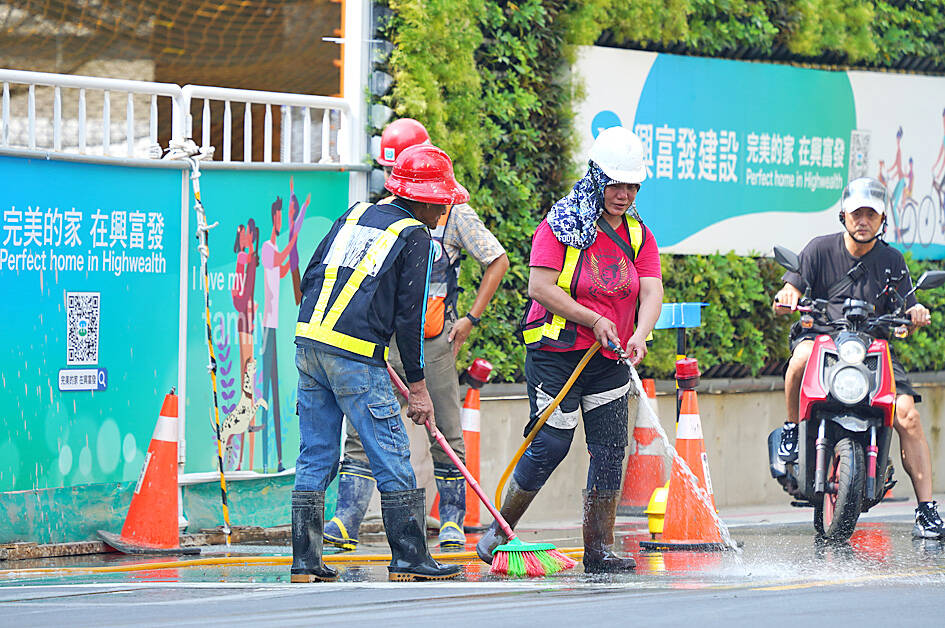The effects of weak global demand on the export-oriented manufacturing sector saw the number of furloughed workers on formal unpaid leave programs in Taiwan rise by 848 to 11,738 from Sept. 7 to Friday last week, the Ministry of Labor said yesterday.
According to the ministry, 712 of the 848 newly furloughed people who worked in the manufacturing sector, for a total of 9,879 workers on unpaid leave programs as of Friday.
The number of employers with furlough programs in place also increased from 601 to 642, with manufacturers accounting for 296 of the total, the ministry said.

Photo: CNA
Labor Conditions and Equal Employment Division Deputy Director Wang Chin-jung (王金蓉) said the metal and electric machinery industry reported an additional 629 workers on unpaid leave programs in the week.
Aa bicycle component maker implemented a furlough program for the first time, Wang said, putting 140 workers on unpaid leave, while a vacuum equipment manufacturer added 170 workers to a total of 180 on unpaid leave.
The two manufacturers cited declining orders as the reason for implementing furlough programs, she said.
Despite the increase in furloughed workers in the industry as a whole, a lamp producer stopped its unpaid leave plan ahead of schedule by putting about 150 workers back on production lines in the week as the company received short-term orders, Wang said.
However, it was too early to say whether the lamp maker’s improved operations would continue, she added.
In the information technology and electronics industry, the number of furloughed workers rose by 151 in the week, with an optoelectronics maker reporting that it had placed about 70 workers on unpaid leave, Wang said.
The labor ministry has provided the latest furlough data in the manufacturing sector to the Ministry of Economic Affairs to help the ministry better understand industry conditions, she said.
On the other hand, the service sector has remained resilient and experienced slight fluctuations in furlough worker numbers amid strong domestic demand in the post-COVID-19 pandemic era, Wang said.
The number of furloughed workers in the retail and wholesale industry rose to 941 as of Friday from 820 on Sept. 7, while the number in the lodging and food and beverage industry has stayed unchanged at 75, the ministry said.
The support service industry, which is comprised of travel agencies, also reported 497 furloughed workers, down from 501 a week earlier, the labor ministry added.

Shiina Ito has had fewer Chinese customers at her Tokyo jewelry shop since Beijing issued a travel warning in the wake of a diplomatic spat, but she said she was not concerned. A souring of Tokyo-Beijing relations this month, following remarks by Japanese Prime Minister Sanae Takaichi about Taiwan, has fueled concerns about the impact on the ritzy boutiques, noodle joints and hotels where holidaymakers spend their cash. However, businesses in Tokyo largely shrugged off any anxiety. “Since there are fewer Chinese customers, it’s become a bit easier for Japanese shoppers to visit, so our sales haven’t really dropped,” Ito

The number of Taiwanese working in the US rose to a record high of 137,000 last year, driven largely by Taiwan Semiconductor Manufacturing Co’s (TSMC, 台積電) rapid overseas expansion, according to government data released yesterday. A total of 666,000 Taiwanese nationals were employed abroad last year, an increase of 45,000 from 2023 and the highest level since the COVID-19 pandemic, data from the Directorate-General of Budget, Accounting and Statistics (DGBAS) showed. Overseas employment had steadily increased between 2009 and 2019, peaking at 739,000, before plunging to 319,000 in 2021 amid US-China trade tensions, global supply chain shifts, reshoring by Taiwanese companies and

Taiwan Semiconductor Manufacturing Co (TSMC, 台積電) received about NT$147 billion (US$4.71 billion) in subsidies from the US, Japanese, German and Chinese governments over the past two years for its global expansion. Financial data compiled by the world’s largest contract chipmaker showed the company secured NT$4.77 billion in subsidies from the governments in the third quarter, bringing the total for the first three quarters of the year to about NT$71.9 billion. Along with the NT$75.16 billion in financial aid TSMC received last year, the chipmaker obtained NT$147 billion in subsidies in almost two years, the data showed. The subsidies received by its subsidiaries —

Taiwan Semiconductor Manufacturing Co (TSMC) Chairman C.C. Wei (魏哲家) and the company’s former chairman, Mark Liu (劉德音), both received the Robert N. Noyce Award -- the semiconductor industry’s highest honor -- in San Jose, California, on Thursday (local time). Speaking at the award event, Liu, who retired last year, expressed gratitude to his wife, his dissertation advisor at the University of California, Berkeley, his supervisors at AT&T Bell Laboratories -- where he worked on optical fiber communication systems before joining TSMC, TSMC partners, and industry colleagues. Liu said that working alongside TSMC